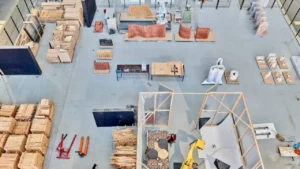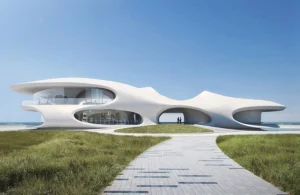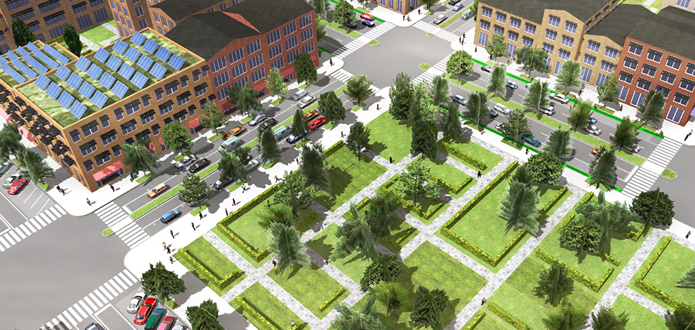The use of 3D printing is revolutionizing urban planning and development by providing new opportunities for design, construction, and sustainability. From custom-made architectural models to 3D-printed buildings, 3D printing is transforming the way cities are planned and built. In this article, we will explore the use of 3D printing in urban planning and development, including its advantages, challenges, and future trends.
Advantages of 3D Printing in Urban Planning and Development
Faster Construction Process
One of the key benefits of 3D printing in urban planning and development is its ability to speed up the construction process. With 3D printing, the construction of buildings and infrastructure can be done more quickly and efficiently than traditional construction methods. This can lead to faster completion times and reduced costs.

Customization and Flexibility
3D printing allows for greater customization and flexibility in design. This means that architects and urban planners can create unique and innovative designs that are tailored to the specific needs of a particular community or project. This can lead to more efficient and sustainable buildings and infrastructure.
Reduced Waste and Environmental Impact
3D printing can also help to reduce waste and environmental impact in urban planning and development. With traditional construction methods, a significant amount of waste is generated during the construction process. However, with 3D printing, materials can be used more efficiently, resulting in less waste.
Improved Precision and Accuracy
3D printing allows for greater precision and accuracy in construction, leading to better quality buildings and infrastructure. This can help to reduce maintenance costs and improve the lifespan of buildings and infrastructure.
Challenges and Considerations
While 3D printing offers many benefits in urban planning and development, there are also challenges and considerations to keep in mind. Here are some of the key challenges:
Cost: The cost of 3D printing technology can be high, particularly for large-scale projects. This can make it difficult for some cities and developers to adopt 3D printing as a key technology in their planning and development needs.
Quality Control: The quality of 3D printed buildings and infrastructure can vary depending on the quality of the printer and the materials used. This can make it difficult to ensure consistent quality across different constructions.
Regulations: There are regulations in place in some jurisdictions that require buildings and infrastructure to meet specific safety and environmental standards. This can make it difficult to adopt 3D printing in construction, particularly for larger-scale projects.
Future Trends in 3D Printing and Urban Planning
As 3D printing and urban planning continue to evolve, there are several future trends that are emerging in the industry. Here are some of the key trends:
Large-Scale 3D Printing
One of the emerging trends in 3D printing is the use of large-scale printers to create entire buildings and infrastructure. This can lead to faster construction times and improved efficiency in the building process.

Sustainable Materials
There is a growing trend towards the use of sustainable materials in 3D printing, particularly in construction. This can help to reduce the environmental impact of urban planning and development.
Smart Cities
The integration of 3D printing with smart city technology is also a growing trend in urban planning and development. By incorporating sensors and other technology into 3D printed buildings and infrastructure, cities can become more efficient, sustainable, and liveable.
One of the key advantages of 3D printing in urban planning and development is the ability to create custom-made architectural models. These models can be used to visualize and test different design concepts, allowing architects and urban planners to make informed decisions about the design of buildings and infrastructure. 3D printing can also be used to create small-scale prototypes of buildings and infrastructure, allowing developers to test and refine designs before beginning construction.
Another advantage of 3D printing is its ability to create complex geometries that would be difficult or impossible to produce using traditional construction methods. This opens up new possibilities for innovative and sustainable design, such as buildings with curved or organic shapes, or infrastructure with intricate internal structures.
3D printing can also be used to create prefabricated building components, such as walls and floors, that can be assembled on-site. This can lead to faster construction times and reduced costs, as well as improved quality control and reduced waste.
In addition to these benefits, 3D printing also offers opportunities for customization and flexibility in urban planning and development. For example, 3D printing can be used to create modular buildings that can be easily reconfigured or expanded over time, allowing for greater adaptability to changing needs and circumstances.
However, there are also challenges and considerations to keep in mind when using 3D printing in urban planning and development. As mentioned earlier, the cost of 3D printing technology can be high, particularly for large-scale projects. In addition, the quality of 3D printed buildings and infrastructure can vary depending on the quality of the printer and the materials used. This can make it difficult to ensure consistent quality across different constructions.
There are also regulations in place in some jurisdictions that require buildings and infrastructure to meet specific safety and environmental standards. This can make it difficult to adopt 3D printing in construction, particularly for larger-scale projects. However, with careful planning and consideration, these challenges can be overcome.
Looking to the future, there are several trends that are emerging in the use of 3D printing in urban planning and development. One of the emerging trends is the use of large-scale printers to create entire buildings and infrastructure. This has the potential to speed up construction times and improve efficiency in the building process.
Another trend is the use of sustainable materials in 3D printing, particularly in construction. This can help to reduce the environmental impact of urban planning and development, and create more sustainable and resilient communities.
The integration of 3D printing with smart city technology is also a growing trend in urban planning and development. By incorporating sensors and other technology into 3D printed buildings and infrastructure, cities can become more efficient, sustainable, and liveable.
In conclusion, the use of 3D printing in urban planning and development is transforming the way cities are designed and built. With faster construction times, greater customization, and reduced environmental impact, 3D printing offers many advantages over traditional construction methods. While there are challenges and considerations to keep in mind, the future possibilities are endless. With careful planning and consideration, 3D printing can be a valuable tool in the creation of more sustainable, efficient, and liveable cities.






